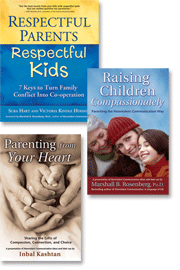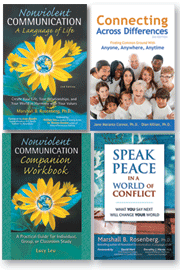Taking a Step Back... continued
If your time out could be taken before the intense anger and frustration surfaces, the tangles would be far easier to unravel, wouldn't they? Instead, what I sometimes do is to take space with a “huff,” implying with my body language and tone that “she is impossible, it’s hopeless, I can’t take anymore of this,” etc.
- In such a moment, I'm often afraid that I have only two choices:
- To hang in there and yank and struggle and fight until we get through this mess, or
- To take space and feel unresolved, disconnected, lonely, worried, unsettled for hours on end until we come back and finish the argument.
I am excited about a new option. We can take time out in love as an expression of caring for the relationship. Our hope is to get back into connection all the sooner and to protect us from making the tangles all the worse. The key is to create a shared understanding with your loved one that the time out is in the service of reconnecting with yourself, rather than to flee the conversation.
During that “taking space” time here are 6 things you can do:
- Think about my part of the tangle to gain clarity about what my reaction was about.
- Don't think at all about the distressing discussing but enjoy the break from the struggle trusting that with rest, new energy and clarity will come organically.
- Translate my Jackals first.
- Translate her Jackals.
- Enjoy music, nature, sports, something totally involving of the mind (reading might be difficult).
- Journal.
Many of the couples I work with struggle to use a time out or “taking space,” because the inner jackals of guilt and self-judgment are simply too rampant for them to hear their needs. Here’s a common example of the pain I see couples in:
The woman is hurt, discouraged, hopeless, and lonely while the man is angry, frustrated, exhausted and scared. The woman’s unmet need is for empathy, closeness and a higher quality of intimate conversation. The man’s need is for respect, rest, validation of his worth as he is, and to unhook himself from his inner sense of guilt and inadequacy about his partner’s pain.
This issue is related to the old freedom/closeness dance — the struggle so many couples have between intimacy and independence or autonomy. Couples can get too dependent on the idea that their partner is the only person who can meet his/her needs, so much so that they keep the fight going long after it's contributing to either of them.
I wish that both men and women would refuse to listen to each other unless they were sure it was a compassionate contribution to the other’s need to be heard instead of a caving-in-concession. May we only “give to” each other and never “give in” to each other lest we breed the slimy serpents of resentment. Taking a time out can often be the best method to “give to” each other when the lines are about to be tangled.
[Of course this dynamic frequently occurs with the genders reversed. But for the sake of simplicity I will continue to describe this yin/yang dynamic in terms of male and female.]
The pain and the emptiness and the loneliness can become so intense for women that they truly become either desperate or hopeless. They get into aggressive demanding, or pleading, or moping around in self-hate/pity, both of which are hard not to interpret as demands.
If they could just get some high quality listening/empathy somewhere it would take some of the charge and intensity off their pain and make it easier to open a dialogue with their mate.
Some women are afraid to do this because they interpret this as infidelity or disloyalty. Others think of it as inappropriately airing the family’s dirty laundry. Still others are afraid of having their vulnerability trampled upon.
The corresponding frustration, irritation and resentment gets so built up in the men that the slightest request triggers the unleashing of the backlog until their partners are walking around on eggshells.
Their resentment comes due to their own self-abandonment. It comes because they have listened when they needed to be heard. It comes because they were trying to be strong and not need to take space and rest and recharge when they needed it. The resentment is there because they didn't know they had a choice not to listen when it didn't fit for them to listen.
Listening to someone when you are really needing to be heard or to rest is violence to the both of you. You violate your responsibility to yourself and begin to hate yourself whenever you don’t take care of your own needs. Also you begin to hate and resent the other and hold the illusion that they are oppressing you.
- He interprets it as accusation. (I hear your pain, and I add it to my list of inadequacies).
- He interprets it as proof of his inadequacy. (If she is still in pain, I must not be adequately providing for her, therefore I must be inadequate).
- He thinks he has no choice but to sit and listen. (We all know we hate whatever we have no choice about; lectures from our Dad, finishing our broccoli, paying taxes.)
- It triggers fear that the relationship is ending, which he wants to avoid.
Because he has such fear of his own anger about his powerlessness, and shame about thinking he is somehow inadequate, sophisticated men learn to go up to their heads to hide behind sophisticated projective, politically, and spiritually correct analytical labels of their partners.
- “She’s just playing victim.” Translation: “I am pissed off that I am choosing to take on responsibility and feel guilty about the pain she is in.”
- “She’s so neeeedy.” Translation: “I am scared to tell her that I have different needs than she does right now partly because of the shame I have about having needs at all, but also because I am afraid I will be abandoned if I don’t meet her needs.”
- “She’s overly dependent.” Translation: “I am confused about how to assert my needs for independence and I am tempted to plead with her to please give me permission to be independent.”
Taking a time out to give yourself empathy, and to connect to the needs behind your jackals or anger can help you transform these unproductive and disconnecting ways of thinking. Think of it as your relationship’s preventive medicine. The next time you sense that the lines are getting tangled, try taking a time out in love, but remember to clarify to your partner your intention for doing so — to contribute to a more loving and productive connection later.
Kelly Bryson MA, MFT, is a CNVC certified trainer and the author of Don’t be Nice, Be Real: Balancing Passion for Self with Compassion for Others. He has been featured in Elle and Shape magazines, appeared on many TV and radio shows, lived in an ashram many years, is a humorist, singer and licensed therapist in private practice.
An inspirational speaker, he keynotes conventions and has trained thousands in NVC in the U.S., Europe and the Middle East. He trains, presents and consults with groups, corporations (Tony Robbins, Paul Mitchell Salons), churches (all flavors), schools (U.Cal.L.B, Body/Mind College), clubs and all types of organizations.
He also studied with E. Stanley Jones, Gandhi’s concierge and friend. To learn more about his work or information about his private or phone-based sessions, and to purchase his book, visit his website at www.LanguageOfCompassion.com or contact him directly at kelly@languageofcompassion.com or 831-462-EARS (3277) (most insurance accepted).
Keep learning these vital communication skills with these books and training resources:
This Month's Specials:
- NVC Parenting Book Package - Save 50% off list price through June 30, 2011
- NVC Starter Kit Book Package - Save 50% off list price through June 30, 2011
Every Day Specials:
- NVC Marshall B. Rosenberg, Ph.D. Book Package - Save 45%-55% on this book package every day from PuddleDancer Press
- NVC Reference Library Package - Save 40%-50% on this book package every day from PuddleDancer Press








